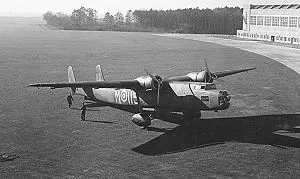Harrow (Total: 102, Canadian: 2, Group 0)
Handley Page Harrow

Harrow of No. 115 Squadron
The Handley Page HP 54 Harrow was a heavy bomber designed and produced by the British aircraft manufacturer Handley Page. It was operated by the Royal Air Force (RAF) and saw use during the Second World War, although it was quickly overshadowed as a bomber by larger and more capable alternatives.
The Harrow was developed during the 1930s as a derivative of the Handley Page HP 51, an unsuccessful monoplane bomber-transport hybrid. It was a twin-engine, high-wing monoplane with a fixed undercarriage. In 1935, the Air Ministry wrote Specification B.29/35 around the Harrow proposal, seeking a 'stop-gap' heavy bomber to facilitate the expansion of the RAF's bomber squadrons. Handley Page updated the design with new features and along with structural changes to better facilitate its rapid construction. Despite incorporating several modern features, including hydraulically-powered turrets, steam-based cabin heating, and variable-pitch propellers, the Harrow was not as capable of equal performance to contemporary bombers such as the Armstrong Whitworth Whitley.
On 14 August 1936, the Air Ministry ordered one hundred Harrows for the RAF. While the Fleet Air Arm also placed a separate order for one hundred Harrows, Handley Page were unable to spare sufficient capacity to produce these aircraft. On 13 January 1937, the first Harrow was delivered to No. 214 Squadron; by the end of that same year, all one hundred of the RAF-bound units had been delivered. By the end of 1939, the Harrow had been rapidly displaced as a frontline bomber, it was flown as a transport aircraft instead, which included its use as an air ambulance. It participated in several major actions, including an unorthodox defensive role for The Blitz in the winter of 1940"“1941 and Operation Market Garden in September 1944. Limited numbers served through to the conclusion of the conflict, the RAF withdrew the Harrow in May 1945. Wikipedia
Harrow Mk. I serial 794
s/n 794
m/d H.P.54
794
Known Units:
Ex RAF K6933, ex G-AFRG. In Newfoundland for in-flight refueling trials when war broke out, purchased by RCAF. With the Test and Development Establishment at RCAF Station Rockcliffe, Ontario, dates unknown. May have been operated initially with civil registration. Assigned to Eastern Air Command, no record of use.last update: 2025-November-19
1941-November-17 Struck off Strength 2019-08-20
Harrow Mk. I serial 795
s/n 795
m/d H.P.54
795
Known Units:
Ex RAF K7029, G-AFRH. In Newfoundland with Flight Refueling, Inc. for in-flight refueling trials when war broke out, purchased by RCAF. With the Test and Development Establishment at RCAF Station Rockcliffe, Ontario, dates unknown. May have been operated initially with civil registration. Held for spares for 794.last update: 2025-November-19
1941-January-22 Struck off Strength Struck off, broken up for spares. 2019-08-20